A quick, elegant dish with bold flavor and simple ingredients
Few dishes strike the perfect balance between elegance and ease like balsamic glazed salmon. With its crispy seared crust and a rich, tangy glaze infused with honey, Dijon mustard, and rosemary, this salmon recipe transforms everyday ingredients into a restaurant-quality meal in under 30 minutes. Whether you’re planning a weeknight dinner or hosting guests, this dish delivers bold flavor with minimal effort.

The beauty of balsamic glazed salmon lies in its versatility. The glaze, made with balsamic vinegar, honey, and fresh rosemary, also works beautifully on chicken, pork, or roasted vegetables. The salmon itself is pan-seared until golden brown, locking in moisture and enhancing the natural richness of the fish. It finishes with a silky, sweet-tart glaze that elevates the entire dish.
Why You’ll Love This Recipe
- Ready in 30 minutes
- Elegant yet approachable
- Packed with protein and omega-3s
- Pairs with a variety of side dishes
- Naturally gluten free and dairy free
This balsamic glazed salmon is proof that healthy eating doesn’t mean sacrificing flavor. The tangy glaze balances the richness of the salmon while the rosemary adds depth and complexity. It’s the kind of meal that feels indulgent but fits easily into a clean-eating lifestyle.
Preparation Phase & Tools to Use
Essential Tools and Equipment
To prepare this recipe efficiently and cleanly, gather the following kitchen tools:
- Non-stick skillet: For even searing and easy cleanup
- Medium saucepan: Ideal for reducing the balsamic glaze
- Fine mesh strainer: To remove solids from the glaze for a smooth finish
- Measuring cups and spoons: For accurate ingredient portions
- Tongs or spatula: For flipping fillets without breaking them
- Paper towels: For drying the salmon thoroughly before searing
Each tool plays a role in ensuring the salmon cooks evenly and the glaze reaches the perfect texture. For instance, a non-stick skillet allows the fish to develop a golden crust without sticking, and a mesh strainer removes rosemary and garlic remnants for a velvety glaze.
Preparation Tips
Before cooking, allow your salmon fillets to rest at room temperature for 10 to 15 minutes. This helps them cook evenly. Pat each fillet dry with paper towels—removing surface moisture is key to getting a crisp, golden crust. Use fresh rosemary for the glaze if possible; dried rosemary can work in a pinch but lacks the same aromatic punch.
If your salmon is skin-on, sear skin-side down first to get a crisp finish. If skinless, be careful when flipping to preserve the fillet’s structure.
Ingredients
For the Balsamic Rosemary Glaze
- ½ cup balsamic vinegar
- ¼ cup white wine or low-sodium chicken broth
- 2 tablespoons honey
- 1 tablespoon Dijon mustard
- 1 sprig fresh rosemary (about 7 inches)
- 1 clove garlic, minced
For the Salmon
- 4 (6 oz) salmon fillets (skin-on or skinless)
- Salt and freshly ground black pepper, to taste
- 2 teaspoons olive oil
- Optional: Finely minced parsley or rosemary for garnish
Step-by-Step Directions
- Bring salmon to room temperature by letting it sit for 10–15 minutes. This ensures even cooking.
- In a medium saucepan, combine balsamic vinegar, white wine or broth, honey, Dijon mustard, rosemary sprig, and minced garlic.
- Bring the mixture to a boil over medium-high heat. Once boiling, reduce the heat to medium-low and let it simmer.
- Stir occasionally, allowing the glaze to reduce and thicken to about ⅓ cup. This will take approximately 10–15 minutes.
- Strain the glaze through a fine mesh strainer into a heatproof bowl and set aside.
- Pat the salmon fillets dry. Season both sides generously with salt and pepper.
- Heat the olive oil in a large non-stick skillet over medium-high heat. Once hot, add the salmon fillets, skin-side down if applicable.
- Sear the salmon without moving it for 3–4 minutes until golden brown and crispy.
- Flip the fillets gently and cook for another 2–3 minutes, or until the salmon flakes easily with a fork.
- Plate the salmon and drizzle with the warm balsamic rosemary glaze. Garnish with fresh parsley or rosemary if desired.
Serving Suggestions for Balsamic Glazed Salmon
Balsamic glazed salmon is incredibly versatile and adapts well to a variety of plating styles and flavor profiles. Whether you’re serving a casual weeknight meal or presenting an elegant dinner, the right accompaniments can elevate this dish even further.
The sweet and tangy glaze pairs beautifully with both bold and subtle flavors. A well-balanced plate will highlight the salmon’s richness while contrasting textures and complementary tastes bring the dish together.
Recommended Serving Ideas
- Over a bed of grains: Serve the salmon on cooked quinoa, farro, or wild rice for a wholesome base that absorbs the glaze.
- Alongside roasted vegetables: Caramelized carrots, Brussels sprouts, or sweet potatoes balance the glaze’s acidity.
- On a salad: Add salmon fillets to a mixed green salad with goat cheese, walnuts, and a light vinaigrette for a healthy, complete meal.
- Paired with mashed root vegetables: Mashed cauliflower or potatoes provide a creamy contrast to the tangy glaze.
- With crusty bread: Sop up extra glaze with a warm slice of sourdough or multigrain bread for a rustic finish.
This dish also pairs well with crisp white wines such as Sauvignon Blanc or a light Pinot Noir, which complement the glaze’s acidity and rosemary undertones.
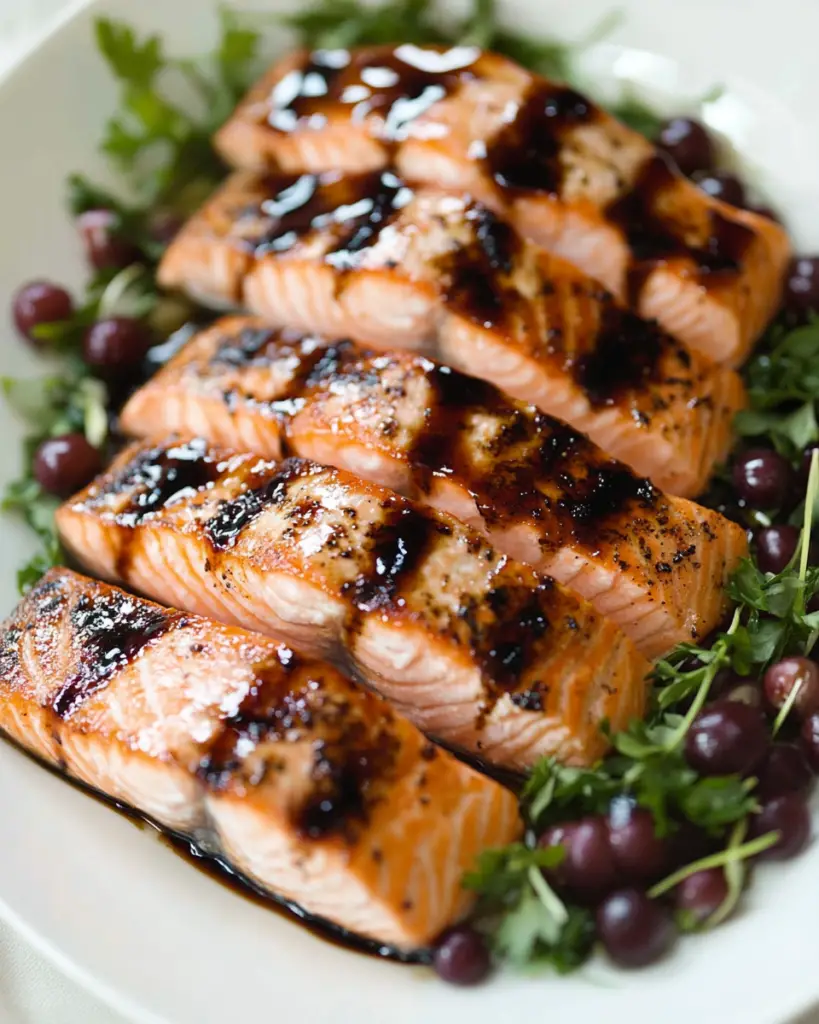
Common Mistakes to Avoid
While balsamic glazed salmon is straightforward to prepare, a few missteps can affect texture and flavor. Avoiding these mistakes will help you achieve perfect results every time.
1. Overcooking the Salmon
Overcooked salmon becomes dry and tough. To avoid this:
- Cook fillets just until they flake easily with a fork.
- Use a meat thermometer and remove the salmon at 125°F. It will continue to cook slightly from residual heat.
2. Not Drying the Fillets
Excess surface moisture prevents a crisp sear. Always pat the salmon dry with paper towels before seasoning and cooking.
3. Using Low-Quality Vinegar
The glaze is only as good as the balsamic vinegar you use. Opt for aged balsamic with a thicker consistency and richer flavor. Avoid very acidic or watery vinegars.
4. Reducing the Glaze Too Quickly
High heat can cause the sugars in honey to burn, resulting in bitterness. Simmer the glaze over medium-low heat and stir occasionally to avoid scorching.
5. Flipping Too Early
Let the salmon sear undisturbed for at least 3 to 4 minutes. Moving it too early can tear the fillets and prevent a good crust from forming.
6. Overcrowding the Pan
Searing too many fillets at once drops the pan’s temperature, leading to steaming instead of browning. Cook in batches if necessary.
Avoiding these common pitfalls ensures a dish with optimal texture, balanced flavor, and elegant presentation.
Best Side Dishes for Balsamic Glazed Salmon
Pairing the salmon with the right side dishes brings out the best in the glaze and creates a well-rounded meal. Below are eight sides that complement this dish in flavor, texture, and color.
1. Garlic Mashed Potatoes
Creamy mashed potatoes provide a neutral, comforting base that contrasts well with the glaze’s sweet and tangy profile.
2. Roasted Asparagus
Crisp-tender asparagus roasted with olive oil and sea salt adds a clean, fresh element to the plate.
3. Lemon Herb Quinoa
A citrusy quinoa brightens up the dish and enhances the rosemary in the glaze, while also adding protein and texture.
4. Sautéed Green Beans
Tossed with garlic and finished with a splash of lemon juice, green beans add crunch and a touch of acidity.
5. Honey Glazed Carrots
Their natural sweetness echoes the honey in the glaze, creating harmony in flavor while adding vibrant color.
6. Arugula Salad with Balsamic Vinaigrette
The peppery bite of arugula and the tangy vinaigrette offer freshness and echo the flavors of the glaze without overpowering the salmon.
7. Cauliflower Rice
Low in carbs and high in fiber, cauliflower rice absorbs extra glaze and adds a light, healthy base.
8. Balsamic Roasted Brussels Sprouts
Brussels sprouts roasted with a touch of balsamic vinegar bring depth and a pleasing bitterness that offsets the glaze’s sweetness.
Each of these side dishes not only complements the main course but also enhances the dining experience by offering contrasting textures and flavors.
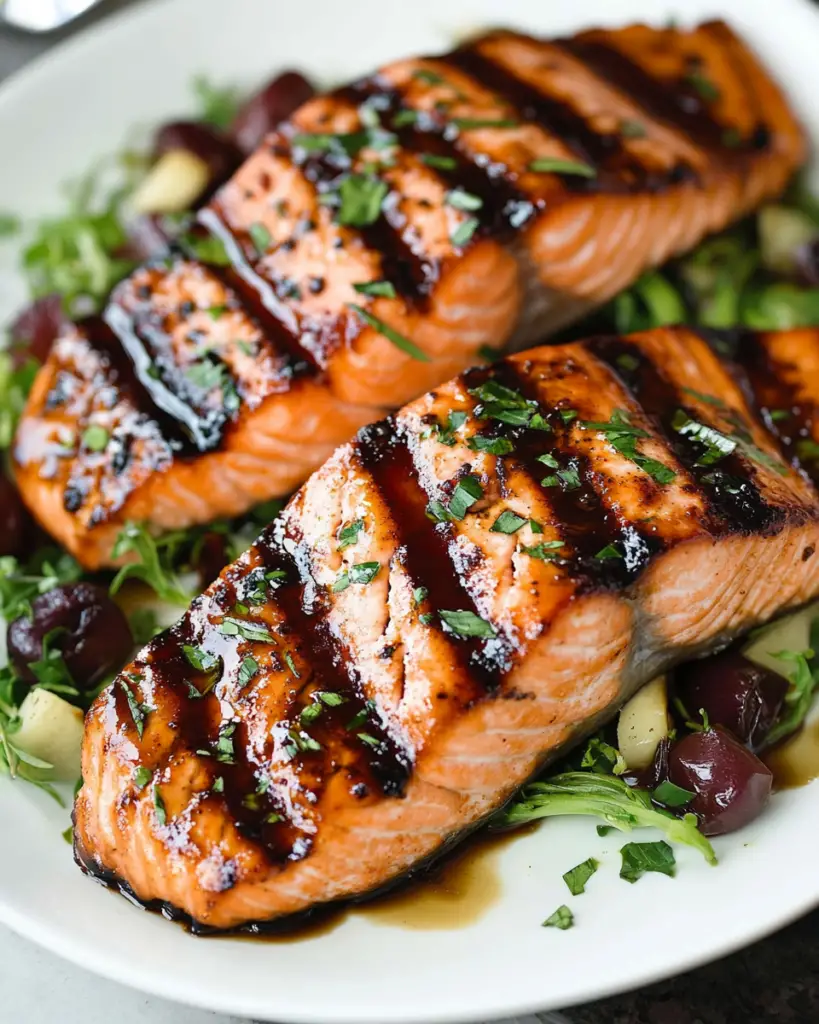
Expert Recipe Tips and Easy Variations
Balsamic glazed salmon is already a well-balanced and flavorful recipe, but a few thoughtful adjustments can personalize it to your preferences or dietary needs.
Tips for Best Results
- Use center-cut fillets: These are more uniform in thickness, ensuring even cooking.
- Let the glaze cool slightly: Allow it to thicken a bit more off heat before serving for better consistency.
- Taste the glaze before serving: If it’s too sharp, add a bit more honey. If too sweet, add a dash more vinegar.
- Don’t skip the straining step: This results in a smooth, restaurant-style glaze.
- Sear the salmon skin-side down first if using skin-on fillets: This helps the skin crisp up and naturally releases from the pan.
Easy Variations
- Spicy version: Add a pinch of crushed red pepper flakes to the glaze for subtle heat.
- Citrus twist: Add a splash of orange juice or zest for a bright citrus note.
- Herb swap: Use thyme or tarragon instead of rosemary for a different herbal profile.
- Maple glaze: Substitute maple syrup for honey for a deeper, earthy sweetness.
- Grilled salmon: For summer months, cook the salmon on a grill and finish with warmed glaze.
These customizations allow you to make the dish your own while still staying true to the original flavors.
Storage and Reheating Instructions
Balsamic glazed salmon is best enjoyed fresh, but it also stores well for later meals.
Storing Leftovers
- Refrigerate cooked salmon in an airtight container for up to 3 days.
- Store glaze separately in a small jar or container in the refrigerator. It keeps well for up to 5 days.
Avoid freezing the glazed salmon if possible. Freezing can affect the texture of the fish and separate the glaze. If you must freeze, do so before glazing.
Reheating Tips
- Stovetop method: Place salmon in a non-stick pan over medium-low heat. Cover loosely and warm for 3 to 4 minutes.
- Oven method: Preheat oven to 275°F. Place salmon on a lined baking sheet and reheat for 10 to 12 minutes.
- Avoid microwave reheating: This method often dries out the fish and can create uneven texture.
Reheat the glaze gently in a small saucepan or microwave for 10–15 seconds before drizzling.
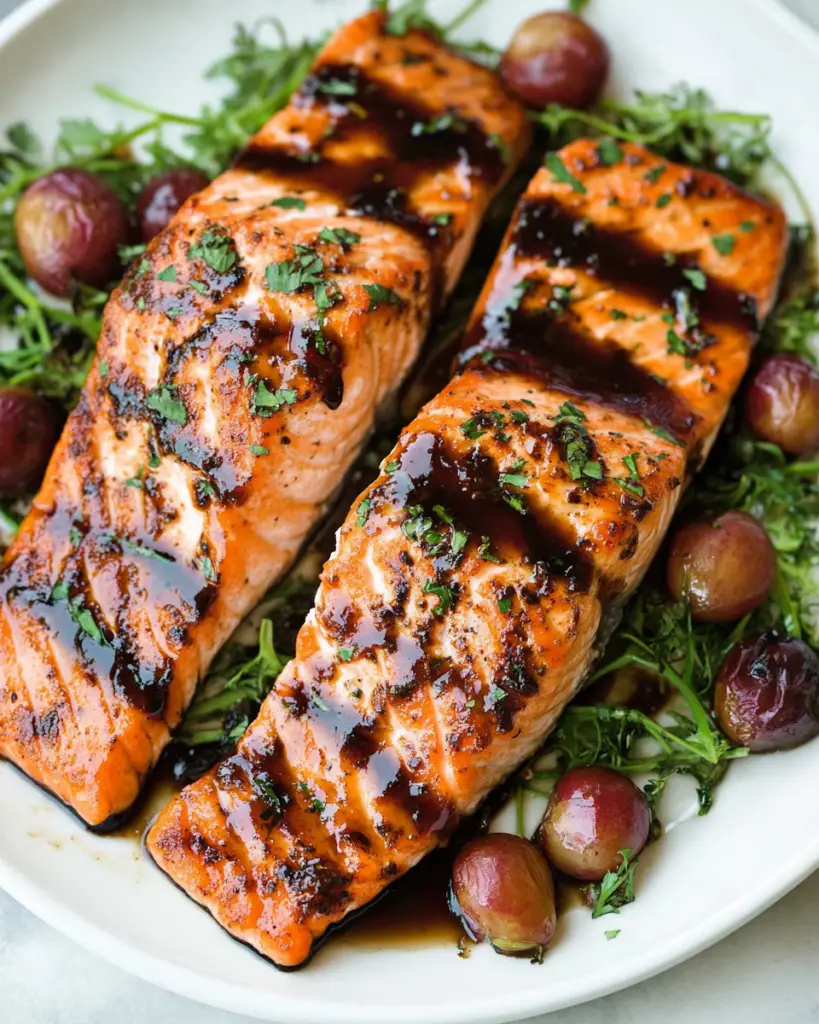
Frequently Asked Questions (FAQs)
Can I bake instead of pan-searing the salmon?
Yes. Bake salmon fillets at 400°F for 12 to 15 minutes. Glaze them after baking or during the last few minutes to avoid burning the sugars in the glaze.
Can I make the balsamic glaze ahead of time?
Absolutely. The glaze can be made 3 to 5 days in advance and stored in the refrigerator. Reheat it gently before serving.
Can I use dried rosemary instead of fresh?
Yes, though fresh rosemary delivers a better flavor. Use 1 teaspoon of dried rosemary in place of a fresh sprig, and strain it well after simmering.
What if I don’t have Dijon mustard?
Substitute with whole grain mustard or a small amount of yellow mustard. The flavor will change slightly, but the glaze will still work.
Is this dish gluten free?
Yes, provided that you use gluten-free broth or wine and verify your mustard is gluten-free. The base ingredients are naturally gluten free.
Can I use frozen salmon?
Yes, just make sure it is fully thawed and patted dry before cooking to prevent water from interfering with the sear.
What wine pairs best with this salmon?
Sauvignon Blanc or Pinot Noir are great choices. Their acidity complements the balsamic glaze, and they pair well with the richness of the salmon.
Final Thoughts
Balsamic glazed salmon is more than just a quick dinner option—it’s an elegant, versatile dish that combines simple ingredients with elevated flavors. The glaze brings a deep complexity to the tender salmon, and the cooking method ensures a crisp exterior and moist, flaky interior.
With endless options for sides and easy variations, this salmon recipe can be tailored for casual family dinners or special occasions. From the first bite, the harmony of honey, balsamic vinegar, and fresh rosemary will impress even the most selective palates.
Whether you’re new to cooking salmon or looking to add a new staple to your rotation, this balsamic glazed salmon delivers every time.
Balsamic Glazed Salmon
Ingredients
For the Balsamic Rosemary Glaze:
- ½ cup balsamic vinegar
- ¼ cup white wine or low-sodium chicken broth
- 2 tablespoons honey
- 1 tablespoon Dijon mustard
- 1 rosemary sprig about 7 inches long
- 1 clove garlic minced
For the Salmon:
- 4 6 oz salmon fillets, skinless or skin-on
- Salt and freshly ground black pepper to taste
- 2 teaspoons olive oil
- Finely minced rosemary or parsley for garnish (optional)
Instructions
- Let the salmon rest at room temperature for 10–15 minutes before cooking.
- In a medium saucepan, combine balsamic vinegar, white wine or broth, honey, Dijon mustard, rosemary sprig, and minced garlic. Bring to a boil over medium-high heat.
- Reduce the heat to medium-low and simmer until the glaze has thickened and reduced to about ⅓ cup, approximately 10–15 minutes, stirring occasionally.
- Remove from heat and strain the glaze through a fine mesh strainer into a heatproof bowl. Set aside.
- Pat the salmon fillets dry with paper towels and season both sides with salt and pepper.
- Heat olive oil in a large non-stick skillet over medium-high heat. Add the salmon fillets and sear, undisturbed, for 3–4 minutes until golden brown on the bottom.
- Flip each fillet carefully and cook for another 2–3 minutes, or until the salmon is just cooked through and flakes easily with a fork.
- Serve the salmon warm, drizzled generously with the balsamic glaze. Garnish with rosemary or parsley if desired.



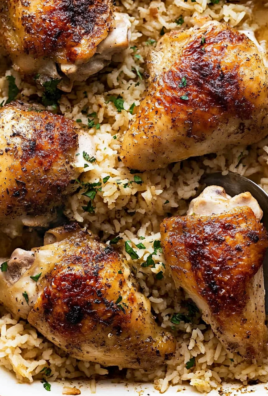
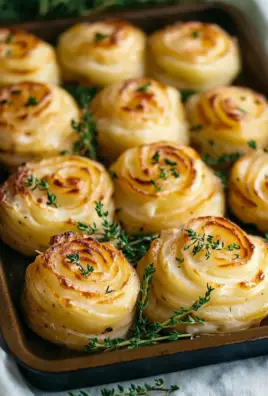
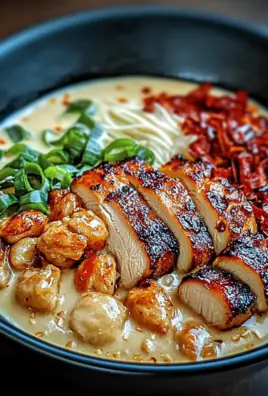
Leave a Comment